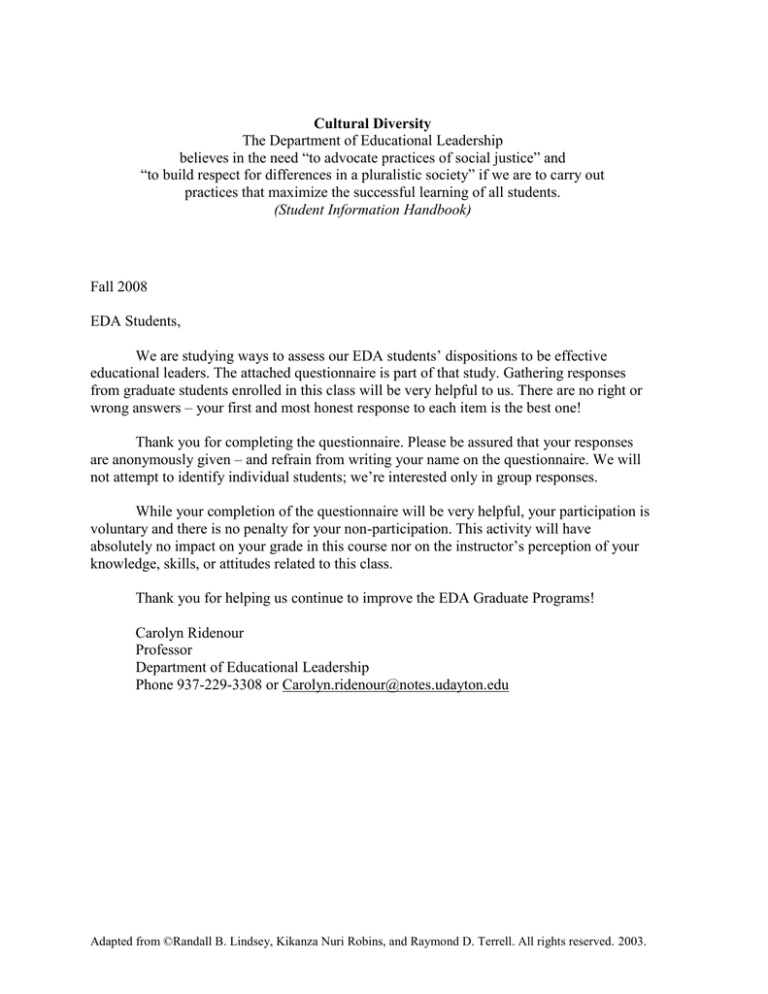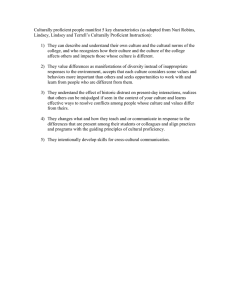
Cultural Diversity
The Department of Educational Leadership
believes in the need “to advocate practices of social justice” and
“to build respect for differences in a pluralistic society” if we are to carry out
practices that maximize the successful learning of all students.
(Student Information Handbook)
Fall 2008
EDA Students,
We are studying ways to assess our EDA students’ dispositions to be effective
educational leaders. The attached questionnaire is part of that study. Gathering responses
from graduate students enrolled in this class will be very helpful to us. There are no right or
wrong answers – your first and most honest response to each item is the best one!
Thank you for completing the questionnaire. Please be assured that your responses
are anonymously given – and refrain from writing your name on the questionnaire. We will
not attempt to identify individual students; we’re interested only in group responses.
While your completion of the questionnaire will be very helpful, your participation is
voluntary and there is no penalty for your non-participation. This activity will have
absolutely no impact on your grade in this course nor on the instructor’s perception of your
knowledge, skills, or attitudes related to this class.
Thank you for helping us continue to improve the EDA Graduate Programs!
Carolyn Ridenour
Professor
Department of Educational Leadership
Phone 937-229-3308 or Carolyn.ridenour@notes.udayton.edu
Adapted from ©Randall B. Lindsey, Kikanza Nuri Robins, and Raymond D. Terrell. All rights reserved. 2003.
Department of Educational Leadership
Cultural Competence Self Assessment
University of Dayton
2008
Please circle a response to each item (1 – 5) that best represents you:
Rarely = 1 Seldom = 2 Sometimes = 3 Often = 4 Usually = 5
Please write any comments that come to mind, if any, as you read the item. Include in
your comments any word or phrase that you think is unclear or that you don’t understand.
We don’t assume that all the words and phrases are familiar to everyone!
1. I am aware of my own culture and ethnicity.
1
2
3
4
5
Comments?
2. I am comfortable talking about my culture and ethnicity.
1
2
3
4
5
Comments?
3. I know the effect that my culture and ethnicity may have on the people in my work
setting.
1
2
3
4
5
Comments?
4. I seek to learn about the culture of my school.
1
2
3
4
5
Comments?
5. I seek to learn about the culture of my school’s employees.
1
2
3
4
5
Comments?
Adapted from ©Randall B. Lindsey, Kikanza Nuri Robins, and Raymond D. Terrell. All rights reserved. 2003.
6. I seek to learn about the cultures of the students and families who attend my school.
1
2
3
4
5
Comments?
7. I anticipate how my school’s students, families, and staff members will interact with,
conflict with, and enhance one another.
1
2
3
4
5
Comments?
8. I welcome a diverse group of students, families, and staff members into the school.
1
2
3
4
5
Comments?
9. I create opportunities in our school for us to be more inclusive and more diverse.
1
2
3
4
5
Comments?
10. I appreciate both the challenges and opportunities that diversity brings.
1
2
3
4
5
Comments?
11. I share my appreciation of diversity with my coworkers.
1
2
3
4
5
Comments?
12. I share my appreciation of diversity with students and families.
1
2
3
4
5
Comments?
Adapted from ©Randall B. Lindsey, Kikanza Nuri Robins, and Raymond D. Terrell. All rights reserved. 2003.
13. I work to develop a learning community with the staff members and families (internal
or external) I serve.
1
2
3
4
5
Comments?
14. I make a conscious effort to teach the cultural expectations of my school to those who
are new or who may be unfamiliar with the school’s culture.
1
2
3
4
5
Comments?
15. I proactively seek to interact with people from diverse backgrounds in my personal
and professional life.
1
2
3
4
5
Comments?
16. I recognize that conflict is a part of life.
1
2
3
4
5
Comments?
17. I work to develop skills to mange conflict in a positive way.
1
2
3
4
5
Comments?
18. I help my colleagues to understand that what appear to be clashes in personalities may
in fact be conflicts in culture.
1
2
3
4
5
Comments?
19. I help the students and families I serve to understand that what appear to be clashes in
personalities may in fact be conflicts in personal or organizational culture.
1
2
3
4
5
Comments?
Adapted from ©Randall B. Lindsey, Kikanza Nuri Robins, and Raymond D. Terrell. All rights reserved. 2003.
20. I check myself to see if an assumption I am making about a person is based on facts
or upon stereotypes about a group.
1
2
3
4
5
Comments?
21. I accept that the more diverse my school becomes, the more we will change and
grow.
1
2
3
4
5
Comments?
22. I realize that once I embrace the principles of cultural proficiency, I, too, must
change.
1
2
3
4
5
Comments?
23. I am committed to the continuous learning that is necessary to deal with the issues
caused by differences.
1
2
3
4
5
Comments?
24. I seek to enhance the substance and structure of the work I do so that it is informed by
the guiding principles of cultural proficiency.
1
2
3
4
5
Comments?
25. I recognize the unsolicited privileges I might enjoy because of my title, gender, age,
sexual orientation, physical ability, or ethnicity.
1
2
3
4
5
Comments?
Adapted from ©Randall B. Lindsey, Kikanza Nuri Robins, and Raymond D. Terrell. All rights reserved. 2003.
26. I know how to learn about people and cultures unfamiliar to me without giving
offense.
1
2
3
4
5
Comments?
27. I work to influence the culture of my school so that is policies and practices are
informed by the guiding principles of cultural proficiency.
1
2
3
4
5
Comments?
28. I speak up if I notice that a policy or practice unintentionally discriminates against or
causes an unnecessary hardship for a particular group in my school’s community.
1
2
3
4
5
Comments?
29. I take advantage of teachable moments to share cultural knowledge or to learn from
my colleagues.
1
2
3
4
5
Comments?
30. I take advantage of teachable moments to share cultural knowledge with families and
students I work with.
1
2
3
4
5
Comments?
31. I seek to create opportunities for my colleagues, students, families, and the
communities we serve to learn about one another.
1
2
3
4
5
Comments?
Adapted from ©Randall B. Lindsey, Kikanza Nuri Robins, and Raymond D. Terrell. All rights reserved. 2003.
In order to obtain a descriptive profile of those who completed this questionnaire, please mark each item
below – describing yourself.
1.
Professional role during 2004-2005 school year :
_____ Classroom Teacher
_____ Principal
If teacher, level and/or subject:
___________________________
___________________________
_____ Central Office Administrator _____ Other
2.
Career Aspirations:
_____ Classroom Teacher
_____ Principal
If teacher, level and/or subject:
___________________________
___________________________
_____ Central Office Administrator _____ Superintendent
_____ Other
3.
Graduate courses completed in EDA at the University of Dayton
As accurately as you can recall, please check the courses you’ve completed before this term (Summer
2005) began:
_____ EDA505
_____ EDA509
_____ EDA510
_____ EDA511
_____ EDA515
_____ EDA551
_____ EDA507
_____ EDA556
_____ EDA555
_____ EDA557
Educational Leadership
Supervision & Professional Development
Instructional Leadership
Curriculum
School Law
Research
Internship 1
Leadership in Diverse Communities
Community Relations
School Finance
_____ EDA610
_____ EDA626
_____ EDA607
_____ EDA651
_____ EDA655
Curriculum Development
Staff Personnel
Internship 2
School Improvement
Principalship
4.
Number of years of experience in classroom teaching, including 2004-2005 school year: _____
5.
Number of years of experience as a school administrator, including 2004-2005 school year: _____
6.
Gender:
_____Male
7.
Ethnicity:
_____ African American
_____ Asian American
_____ European American
_____ Hispanic or Latino/Latina American
_____ Native American
_____ Other
_____ Female
THANK YOU VERY MUCH FOR YOUR PARTICIPATION IN THIS PILOT STUDY! Your responses
are very helpful to us as we plan for the future!
Adapted from ©Randall B. Lindsey, Kikanza Nuri Robins, and Raymond D. Terrell. All rights reserved. 2003.
Adapted from ©Randall B. Lindsey, Kikanza Nuri Robins, and Raymond D. Terrell. All rights reserved. 2003.



